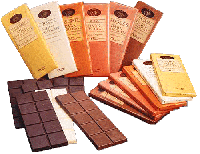Gourmet Chocolate House Tour
A Guide To The World’s Great Chocolate Houses
On our first tour, in 2005, we visited these great chocolate producers (in alphabetical order):
Amedei (Italy), Chocovic (Spain), Domori (Italy), El Rey (Venezuela), Michel Cluizel (France),
Pierre Marcolini (Belgium), Pralus (France), Scharffen Berger* (U.S.), and Valrhona‡ (France).
*Kosher †Organic ‡Some Organic Items
In 2006, our tour took us to Bonnat* (France) Dagoba*† (U.S.), Guittard* (U.S.),
Plantations (U.S.) and Santander* (Colombia).
ON THIS PAGE:
 Colombia Colombia
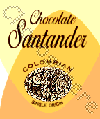 Santander Santander
Nacional Cacao • Cherry Fruit • Marshmallow • Kosher
Historic Capsule
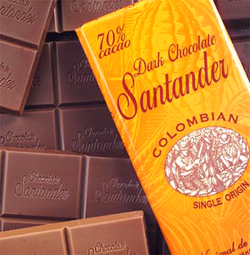 Santander, the name of the company, is actually the name of a region in Colombia where the cacao is grown. The chocolate is manufactured by Compañía Nacional de Chocolates, founded in 1920. For more than 50 years Santander has been promoting ethical cultivation practices that are now very current, including the use of organic fertilizers, species preservation and soil protection through forest conservation. The company also works directly with cacao growers to maintain an equitable and fair trade foundation that benefits the growers, company, and consumers. Santander upholds social responsibilities as well, such as sponsoring educational programs for community children. A long list of its community and social activities can be found on its website, in addition to wonderful pictures and delicious chocolate. Santander, the name of the company, is actually the name of a region in Colombia where the cacao is grown. The chocolate is manufactured by Compañía Nacional de Chocolates, founded in 1920. For more than 50 years Santander has been promoting ethical cultivation practices that are now very current, including the use of organic fertilizers, species preservation and soil protection through forest conservation. The company also works directly with cacao growers to maintain an equitable and fair trade foundation that benefits the growers, company, and consumers. Santander upholds social responsibilities as well, such as sponsoring educational programs for community children. A long list of its community and social activities can be found on its website, in addition to wonderful pictures and delicious chocolate.
What To Know Before You Go
Since Santander’s chocolate is entirely made from Nacional cacao, anticipate an exceptional chocolaty impact in varying degrees, depending upon percentage. A common theme tying all the bars together is a characteristic cherry cordial and marshmallow flavor. Definitely “red fruit” in overall character, Colombian cacao’s natural flavor is wonderfully and uniquely highlighted in this line due to Santander’s exclusive use and intimate knowledge of the beans.
Points of Interest: All Single Origin Colombian Cacao
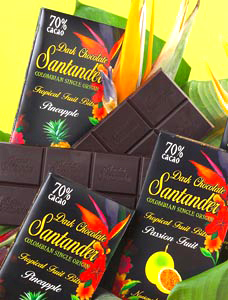 The bars Santander offers come in varying guises. To taste the cacao in all its purist form, try the unflavored bars. The 70% Cacao bar is the strongest offering. Bitter but refreshingly so, this bar is never off-putting and even has a cheerful persona due to the cherry cordial flavor. Next is the 65% bar, which is characterized by tropical fruits and a softer red flavor. Moving down the line to less intense cacao, the 53% bar is the mildest of the dark bars but still just as impressive, conjuring up flavors of marshmallows melting in a steaming cup of hot cocoa. And for milk chocolate lovers, the 36% Cacao bar, although a bit sweet, is also quite chocolaty and surprisingly complex. The bars Santander offers come in varying guises. To taste the cacao in all its purist form, try the unflavored bars. The 70% Cacao bar is the strongest offering. Bitter but refreshingly so, this bar is never off-putting and even has a cheerful persona due to the cherry cordial flavor. Next is the 65% bar, which is characterized by tropical fruits and a softer red flavor. Moving down the line to less intense cacao, the 53% bar is the mildest of the dark bars but still just as impressive, conjuring up flavors of marshmallows melting in a steaming cup of hot cocoa. And for milk chocolate lovers, the 36% Cacao bar, although a bit sweet, is also quite chocolaty and surprisingly complex.
Flavored bars are available in four varieties, all in a 70% base. Coffee lovers take notice, as two bars are flavored with Colombian-grown coffee, one with coffee bits for added texture and bursts of coffee flavor and another with coffee flavor infused into the chocolate. Fruit fans can rejoice as well: passionfruit bits add zest and pep to one bar, while pineapple bits in another bar are milder and more complacent.
Not to be Missed
70% Cacao. This bar really exemplifies the heart of Santander, and Colombian cacao in general. Very archetypical for the bean, it’s both strong and flavorful and just an all-around excellent chocolate.
Santander Chocolates are certified kosher by the Medellin Rabbinate.
 Spain Spain
 Chocovic Chocovic
Pure Origin • Dark Roast • Pure Taste
Historic Capsule
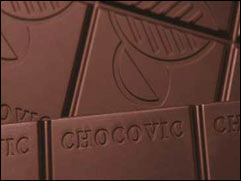 Opening its doors in 1872 as Chocolates Arumi in the Barcelona-area city of Vic, Chocovic changed its name in 1977, when Netherlands purchased the company. From that point, Chocovic’s emphasis became focused on supplying the pastry industry with top-notch chocolate. In 1995, Chocovic started Au la Chocovic, the first school in Spain to specialize in chocolate and teach courses in chocolate, food technology and baking essentials. The company’s emphasis continues to be to supply the pastry industry with top-notch chocolate rather than to focus on the consumer.¹ Their product line is the base for many fine chocolatier and pastry collections throughout Europe and the United States. Still, they produce excellent bars for consumers to enjoy. Opening its doors in 1872 as Chocolates Arumi in the Barcelona-area city of Vic, Chocovic changed its name in 1977, when Netherlands purchased the company. From that point, Chocovic’s emphasis became focused on supplying the pastry industry with top-notch chocolate. In 1995, Chocovic started Au la Chocovic, the first school in Spain to specialize in chocolate and teach courses in chocolate, food technology and baking essentials. The company’s emphasis continues to be to supply the pastry industry with top-notch chocolate rather than to focus on the consumer.¹ Their product line is the base for many fine chocolatier and pastry collections throughout Europe and the United States. Still, they produce excellent bars for consumers to enjoy.
¹With the exception of Pierre Marcolini, the smallest of the great houses, all of the companies profiled produce couverture for professional patissiers and chocolatiers. Thus, in addition to producing bars and bonbons under their own brand names, they sell 2-kilo blocks of chocolate that get turned into bars, bonbons and other chocolate products by other chocolate companies large and small, which sell them under their own brand names. Some chocolatiers will have the house make special blends for them, but the majority use the basic house couverture. As a student of chocolate, you can learn to recognize which couverture your favorite chocolatier uses. Our own top three favorite chocolate boutiques use El Rey, Valrhona, and Domori, for example. Do ask your favorite chocolatiers what brand of couverture they use: it’s not a trade secret (although their precise blends may be); and they will be impressed by the depth of your knowledge and your interest in the craft.
What To Know Before You Go
Like Domori, Chocovic excludes both lecithin and vanilla from the chocolate, which allows the taster to experience the true essence of the bean. Slightly bitter, smooth in the mouth, these bars are a fine attempt to highlight the beans’ inherent natural flavor profile. The overall flavor is neither sharp nor burnt, indicating that roasting time may be on the darker side.
Points of Interest
For consumers, Chocovic has created an Origen Unico (Unique Origin) line of three bars. The company produces several other chocolates in couverture format (two-kilo blocks) for professional use. [Note that while couverture chocolate has added cocoa butter to create a creamier and shinier product that enables fine, detailed chocolate molding and artistic work, it is not only edible by itself, but exquisite to those who like a creamier style.]
- The bars in the Origen Unico line are all 71% cacao and represent not only single origin, but single bean. The line features one bar from each of the three types of beans: Forastero, Criollo, and Trinitario. This allows the taster to experience each bean in its unadulterated form.
- Ocumare, a Criollo from Venezuela, is soft yet explosive on the palate with tones of sweet spice and mild red fruits. Guaranda, a Forastero grown in Ecuador, is strong yet soothing, with woody notes of spice, light citrus, and pure cocoa. Guyave, a Trinitario grown in Grenada, dazzles with unripe banana, pineapple, and mango notes.
- New blended bars include “the three precious stones of Chocovic,” Opal 31% white chocolate, Jade 40% milk chocolate and Maragada* 70% semisweet chocolate.
*A Brazilian gemstone resembling the emerald.
|
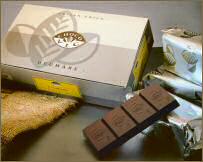
A box of Ocumare bars. |
Not to be Missed
Guyave, a personal favorite of the author. With unripe banana, pineapple, and mango flavors, it’s a choco-tropical must-try.
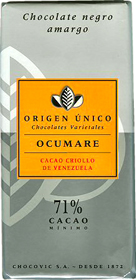 |
Learn more about Chocovic
including the Aula Chocovic school, at
Chocovic.es
Purchase Chocovic at
Chocosphere.com
Chocovic is certified kosher by OU (not all products in the line are certified) |
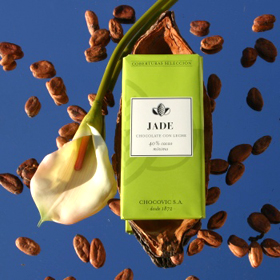 |
One of the author's favorites bars:
Chocovic’s Guyave. |
|
One of the Editorial Director’s favorite bars: Chocovic’s Jade white chocolate. |
 Venezuela Venezuela
 El Rey El Rey
Old-Style • Authentic • 100% Venezuelan
Historic Capsule
Established in 1929, El Rey’s head office and production sites are located in Venezuela: It is the first modern chocolate plant in a Latin American country. El Rey combines Old World cacao tradition with New World technology to produce some unique chocolate. The company’s mission is to deliver 100% pure Venezuelan bean flavor without blending. In 1994, El Rey introduced its Carenero Superior line, chocolate bars of varying cocoa contents that are made entirely from the Carenero Superior Criollo bean.
What to Know Before You Go
El Rey’s texture might be the first striking feature—it’s a little grainy. Even the two bars with extra cocoa butter (which adds smoothness) Mijao and Apamate, have a rather grainy consistency. But it is this texture that makes El Rey unique. Harkening back to the olden days of cacao, the texture gives the taster a more authentic, indigenous experience, with some European touches. Flavor-wise, Carenero can vary from more nutty tones in Apamate to a stronger, fruity sharpness in Gran Saman. Bucare is right in the middle, with moderate tones that appeal to everyone. |
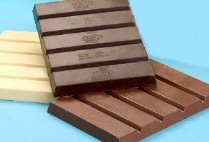
Icoa, Apamate and Caoba: three celestial contributions to the chocolate canon. |
Points of Interest
El Rey’s Carenero Superior line was launched in 1994. Each bar is made exclusively from one type of bean: the highly acclaimed Carenero Superior. Carenero grows in the fertile and humid region of Barlovento, just northeast of Caracas. The well-fermented and better quality beans get deemed “superior”—hence the Carenero Superior designation. The beans are prized for yielding a complexity of spicy and fruity flavors and aromas.
- El Rey produces six bars, including the Icoa white, Caoba 41% milk, Bucare 58.5% dark, Mijao 61% dark, Gran Saman 70% dark, and the Apamate 73.5% dark. Each of the milk and dark bars are named after the taller trees that have provided shade for cacao trees since the 1600s. Icoa is the name of a beautiful goddess believed to possess a white soul. (Read more about Icoa in our review of the world’s best white chocolate.)
- What sets the Carenero Superior line apart from other chocolates is that each of the four dark bars is presented in a range of varying cocoa butter and cocoa liquor contents. So, not only can one discern the differences that differing amounts of cocoa liquor impose on the final flavor; one also can taste the effects of varying amounts of cocoa butter on the same chocolate.
-
For example, Mijao, with a base of Bucare, has slightly more cocoa butter added. Likewise, Apamate, with a base of Gran Saman, has a higher cocoa butter content. Taste each one side-by-side and see for yourself Bucare with Mijao and Gran Saman with Apamate. The differences are amazing. You’ll be surprised at how extra cocoa butter of the latter two can affect flavor.
Not to be Missed
Icoa: simply the best white chocolate in the world. Because El Rey does not deodorize its cocoa butter (a chemical process in production meant to rid undesirable odors, but which also strips flavor in the process), this is the one white chocolate that still possesses its natural chocolate flavors, and not just dairy tones.
Continue to Page 4: United States & Belgium.


|
 |
|











 Colombia
Colombia Santander
Santander  Santander, the name of the company, is actually the name of a region in Colombia where the cacao is grown. The chocolate is manufactured by Compañía Nacional de Chocolates, founded in 1920. For more than 50 years Santander has been promoting ethical cultivation practices that are now very current, including the use of organic fertilizers, species preservation and soil protection through forest conservation. The company also works directly with cacao growers to maintain an equitable and fair trade foundation that benefits the growers, company, and consumers. Santander upholds social responsibilities as well, such as sponsoring educational programs for community children. A long list of its community and social activities can be found on its website, in addition to wonderful pictures and delicious chocolate.
Santander, the name of the company, is actually the name of a region in Colombia where the cacao is grown. The chocolate is manufactured by Compañía Nacional de Chocolates, founded in 1920. For more than 50 years Santander has been promoting ethical cultivation practices that are now very current, including the use of organic fertilizers, species preservation and soil protection through forest conservation. The company also works directly with cacao growers to maintain an equitable and fair trade foundation that benefits the growers, company, and consumers. Santander upholds social responsibilities as well, such as sponsoring educational programs for community children. A long list of its community and social activities can be found on its website, in addition to wonderful pictures and delicious chocolate. The bars Santander offers come in varying guises. To taste the cacao in all its purist form, try the unflavored bars. The 70% Cacao bar is the strongest offering. Bitter but refreshingly so, this bar is never off-putting and even has a cheerful persona due to the cherry cordial flavor. Next is the 65% bar, which is characterized by tropical fruits and a softer red flavor. Moving down the line to less intense cacao, the 53% bar is the mildest of the dark bars but still just as impressive, conjuring up flavors of marshmallows melting in a steaming cup of hot cocoa. And for milk chocolate lovers, the 36% Cacao bar, although a bit sweet, is also quite chocolaty and surprisingly complex.
The bars Santander offers come in varying guises. To taste the cacao in all its purist form, try the unflavored bars. The 70% Cacao bar is the strongest offering. Bitter but refreshingly so, this bar is never off-putting and even has a cheerful persona due to the cherry cordial flavor. Next is the 65% bar, which is characterized by tropical fruits and a softer red flavor. Moving down the line to less intense cacao, the 53% bar is the mildest of the dark bars but still just as impressive, conjuring up flavors of marshmallows melting in a steaming cup of hot cocoa. And for milk chocolate lovers, the 36% Cacao bar, although a bit sweet, is also quite chocolaty and surprisingly complex.  Spain
Spain
 Opening its doors in 1872 as Chocolates Arumi in the Barcelona-area city of Vic, Chocovic changed its name in 1977, when Netherlands purchased the company. From that point, Chocovic’s emphasis became focused on supplying the pastry industry with top-notch chocolate. In 1995, Chocovic started Au la Chocovic, the first school in Spain to specialize in chocolate and teach courses in chocolate, food technology and baking essentials. The company’s emphasis continues to be to supply the pastry industry with top-notch chocolate rather than to focus on the consumer.¹ Their product line is the base for many fine chocolatier and pastry collections throughout Europe and the United States. Still, they produce excellent bars for consumers to enjoy.
Opening its doors in 1872 as Chocolates Arumi in the Barcelona-area city of Vic, Chocovic changed its name in 1977, when Netherlands purchased the company. From that point, Chocovic’s emphasis became focused on supplying the pastry industry with top-notch chocolate. In 1995, Chocovic started Au la Chocovic, the first school in Spain to specialize in chocolate and teach courses in chocolate, food technology and baking essentials. The company’s emphasis continues to be to supply the pastry industry with top-notch chocolate rather than to focus on the consumer.¹ Their product line is the base for many fine chocolatier and pastry collections throughout Europe and the United States. Still, they produce excellent bars for consumers to enjoy. 





